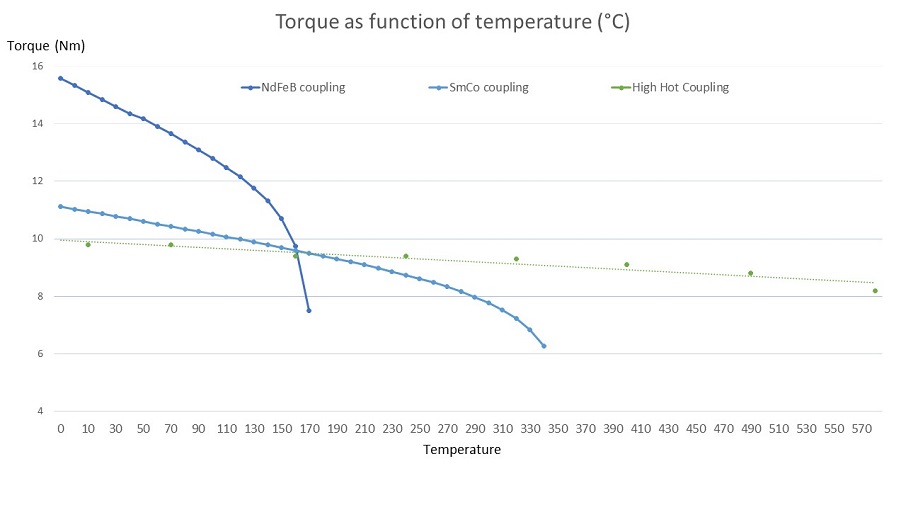Magnetic couplings are used in many applications within pump, chemical, pharmaceutical, process and safety industries. They are typically used with the purpose of reducing wear, sealing of liquids from the environment, cleanliness needs or as a safety factor to brake over if torque suddenly rises.
The most common magnetic couplings are made with an outer and inner drive, both build up with Neodymium magnets in order to get the highest torque density as possible. By optimizing the diameter, air gap, magnet size, number of poles and choice of magnet grade, it is possible to design a magnetic coupling that suits any application in the range from few millinewton meter up to several hundred newton meters.
When only optimizing for high torque, the designers often tend to forget considering the influence of temperature. If the designer refers to the Curie point of the individual magnets, he will claim that a Neodymium magnet would fulfill the requirements up to more than 300°C. Concurrently, it is important to include the temperature dependencies on the remanence, which is seen as a reversible loss – typically around 0,11% per degree Celsius the temperature rises.
Furthermore, a neodymium magnet is under pressure during operation of the magnetic coupling. This means that irreversible demagnetization will occur long before the Curie point has been reached, which typically limits the use of Neodymium-based magnetic coupling to temperatures below 150°C.
If higher temperatures are required, magnetic couplings made of Samarium Cobalt magnets (SmCo) are typically used. SmCo is not as strong as Neodymium magnets but can work up to 350°C. Furthermore, the temperature coefficient of SmCo is only 0,04% per degree Celsius which means that it can be used in applications where performance stability is needed over a larger temperature interval.
New generation In collaboration with Copenhagen Atomics, Alfa Laval, Aalborg CSP and the Technical University of Denmark a new generation of magnetic couplings has been developed by Sintex with support from the Danish Innovation Foundation.
The purpose of the project was to develop a magnetic coupling that could expand the working temperature area to reach temperatures of molten salts around 600°C. By exchanging the inner drive with a magnetic material containing a higher Curie point and boosting the magnetic field of the outer drive with special magnetic designs; it was possible to develop a magnetic coupling that started at a lower torque level at room temperature, but only had a minor reduction in torque level as a function of temperature. This resulted in superior performance above 160°C, no matter if the benchmark was against a Neodymium- or Samarium Cobalt-based system. This can be seen in Figure 1, where it is shown that the torque level of the High Hot drives has been tested up to 590°C on the inner drive and still performed with an almost linear reduction in torque.
The graph also shows that the temperature coefficient of the High Hot coupling is even lower than for the SmCo-system, which opens a lower temperature market where performance stability is important over a larger temperature interval.
Conclusion At Sintex, the R&D department is still developing on the technology, but they need to be challenged on torque level at either different temperature, dimensions of the magnetic coupling or new applications that have not previously been possible with standard magnetic couplings, in order to harvest the full potential of the High Hot technology.
The High Hot coupling is not seen as a standardized shelf product, but instead as custom-built by which is optimized for specific applications. Therefore, further development will be made in close collaboration with new partners.


